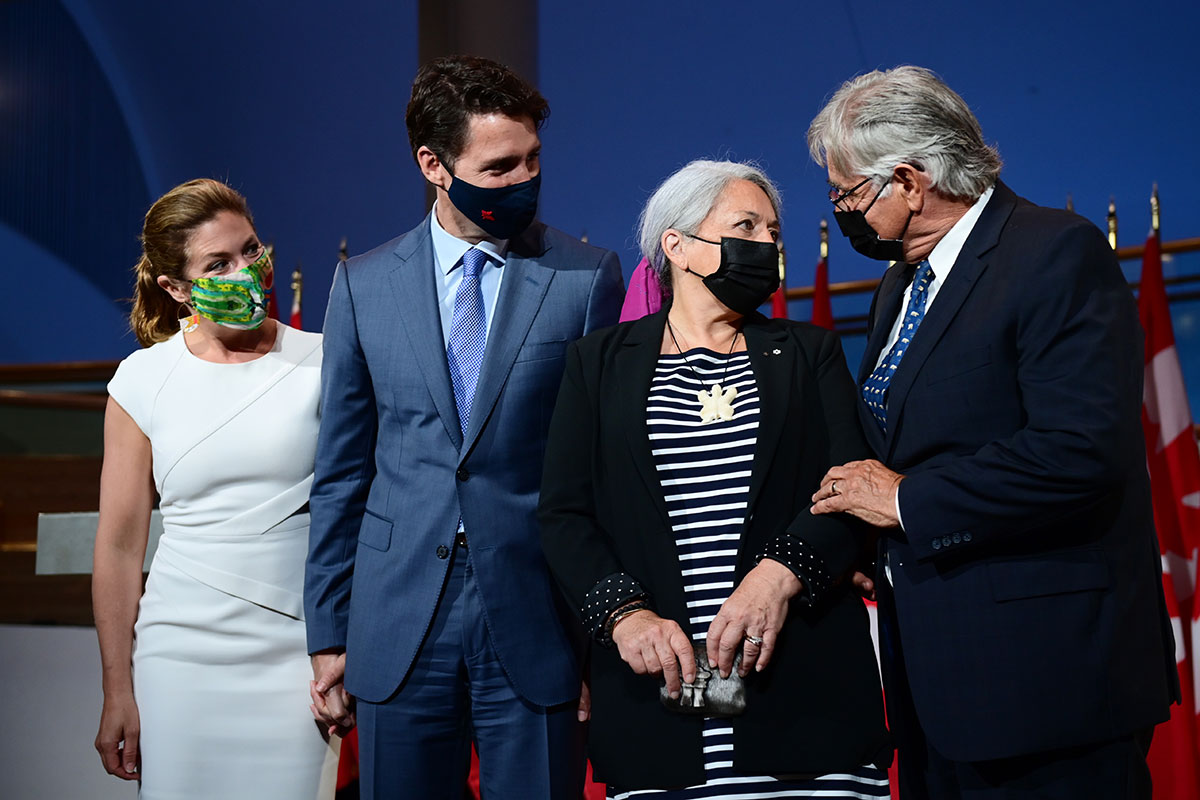
Mary Simon, an Inuk leader and former Canadian diplomat, has been named as Canada’s next governor general — the first Indigenous person to serve in the role. // THE CANADIAN PRESS/Sean Kilpatrick
Should bilingualism change in Canada? The debate over Gov. Gen. Mary Simon
Raymond Théberge, Canada’s official languages commissioner, says his office has received more than 400 complaints about the appointment of Inuk leader Mary Simon as governor general.
The “problem” is her lack of French-English bilingualism, although she is bilingual, speaking both Inuktitut and English.
Canada has had an official bilingualism policy for 50 years, established to deal with a 1960s constitutional crisis regarding francophone Canadians.
Today a very different crisis presents itself: the reckoning of Canada’s colonial practices towards Indigenous people. The uncomfortable clash between different minority languages is coming to a head with the appointment of Simon.
But which languages “count” in Canada? And who gets to be the “right” kind of bilingual?
Anglophones vs. francophones
In the 1960s, the Canadian government was dealing with the Révolution Tranquille (Quiet Revolution) in Québec. This period of social unrest caused the Catholic Church’s influence to decline and placed language at the forefront of Québécois identity.
This was after a long history of economic asymmetry in Québec. In the 18th and 19th centuries, the English made up the bulk of the governing and merchant class, while the French laboured for the English (for instance as coureurs de bois, or unlicensed fur traders), or lived on subsistence farms. Overall, the French were more populous, but also more rural, less educated and poorer.
This pattern changed only slightly over the decades, coming to a head in the 1960s during the Laurendeau-Dunton Commission — also known as the Bilingualism and Biculturalism Commission — that revealed deep economic and social inequities between francophones and anglophones in Québec.
In order to raise the status of francophones in Canada, Pierre Trudeau’s government passed the Official Languages Act in 1969 (revamped in 1985), giving French equal institutional status as English.
This set the stage for today, where most Canadians take official bilingualism as a given. It is perhaps unsurprising, then, that Simon’s lack of French fluency would raise some eyebrows.
Bilingualism vs. Multiculturalism
The Official Languages Act has always been at odds with Canada’s claims of multiculturalism. The Canadian ideal was to promote multiple cultures while promoting only two languages, or as linguist Eve Haque has called it, “Multiculturalism within a Bilingual Framework.”
However, given that language is usually believed to be an essential component of culture (indeed, Québecers argued this), this is already a tenuous policy.
When we establish “official” languages, we demote all other languages to “unofficial.” Equality is only for French and English, not for Cree, or Mohawk, or Inuktitut, or even German — whose speakers have always greatly outnumbered French speakers on the Prairies. In fact, the 2016 census reports more than 66,000 German mother-tongue speakers in Manitoba, compared to 46,000 French mother-tongue speakers.
Current language policy in Canada establishes a hierarchy of French and English above all other languages that underpins how we talk about everything in this country. The census reports on French and English separately, but groups all other languages together. Being bilingual only “counts” if it is French-English.
This is why more than 400 complainants to the official languages commissioner consider Simon’s bilingualism inadequate, despite Inuktitut being one of three official languages of Nunavut.
Although most may agree that it is always desirable to speak an Indigenous language, it is in addition to French and English, not as a replacement.
Indigenous language endangerment
Fast forward 50 years from the Official Languages Act, and there is a different crisis afoot in Canada.
Today we are reckoning with decades of colonial government practices towards Indigenous people and languages. Policies such as residential schools and the 60s scoop were the direct cause of Indigenous language loss.
Removing children from their families and forcing them to learn an “official” language resulted in an abrupt end of familial language transmission for nearly all of the 70-plus Indigenous languages spoken in this country.
The Truth and Reconciliation Commission (TRC) Calls to Action include the revitalization and re-establishment of these languages. The federal government response to these recommendations led to the Indigenous Languages Act of 2019.
Canada’s Official Languages Act states that it will “advance the equality of status and use of the English and French languages within Canadian society.” And the Indigenous Languages Act states that the “recognition and implementation of rights related to Indigenous languages are at the core of reconciliation with Indigenous peoples, and are fundamental to shaping the country.”
How can Canada reconcile the two?
While French remains a minority language in Canada, many Indigenous languages are on the brink of extinction. Inuktitut is among the Indigenous languages most spoken today as a mother tongue, and even it is declining. The federal government and all Canadians have an obligation to work towards reconciliation with Indigenous people, and to implement the TRC recommendations.
Recognizing Indigenous languages as equal in status to French and English, and accepting Inuktitut-English bilingualism in a first Indigenous governor general, would be a good start.
This article from Nicole Rosen (Professor and Canada Research Chair in Language Interactions, University of Manitoba) originally appeared on The Conversation. It appears here under a Creative Commons licence.
Research at the University of Manitoba is partially supported by funding from the Government of Canada Research Support Fund.






